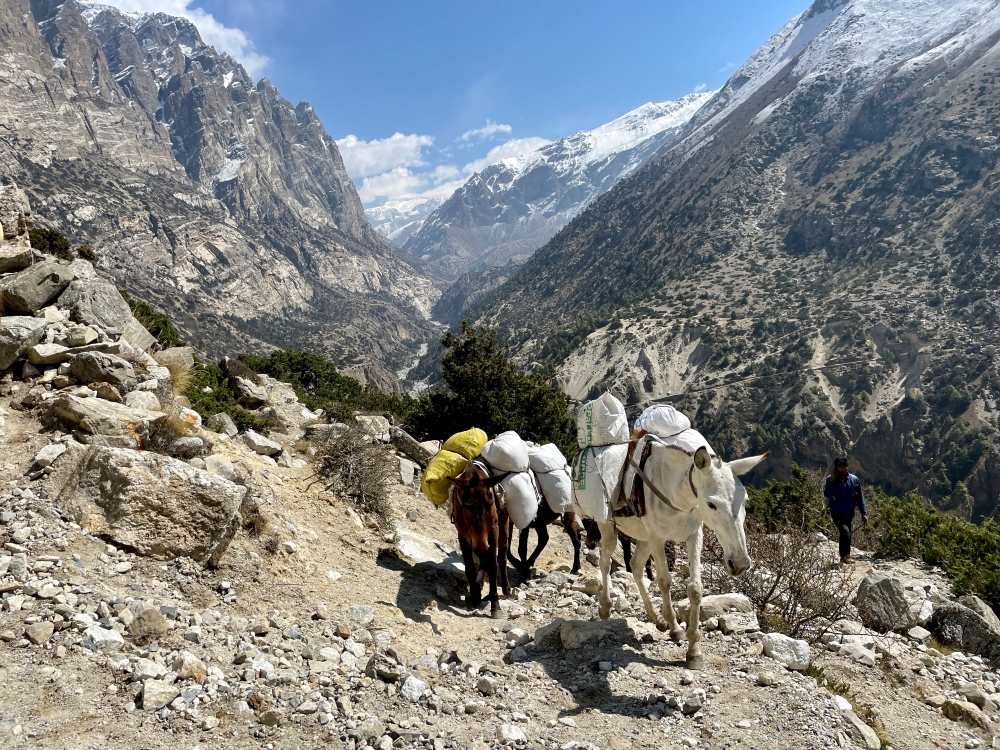Joint conservation for snow leopards in Nepal

Looking down Nar valley. Credit - Ashleigh Lutz-Nelson.
Integrating local government and community conservation capacity for snow leopards
Lying in the rain shadow of the mighty Annapurna and Dhaligiri mountain ranges in Nepal's Annapurna Conservation Area, the Mustang and Manang valleys harbour one of the highest concentrations of snow leopards (Panthera uncia), listed as threatened on the International Union for Conservation of Nature’s Red List. This remote high-altitude habitat is shared by approximately 3,200 households alongside the snow leopard's main prey, the Blue sheep (Pseudois nayaur). The Snow Leopard Conservancy (SLC) collaborates with Nepali NGO Mountain Spirit, local Rural Municipality officials, and communities to safeguard these leopards, their habitat, and improve the lives of local herding communities.
The project employs a multidisciplinary approach to empower communities and governments to work together for sustainable conservation. Key initiatives include enhancing traditional corrals with gabion wire fencing, fortifying windows and openings with iron bars, and installing Foxlights (random blinking lights) to deter snow leopard attacks on livestock. Additionally, the partnership promotes insurance schemes to compensate for livestock losses due to depredation and natural disasters, while raising community awareness about government policies on livestock compensation and overall livestock-community well-being. The partnership also fosters enterprise opportunities through skills training, cooperative formation, and local product branding. An example is the launching of an enterprise to cultivate and market Himalayan chives (Allium sp. or Jimbu in Nepali), valued for its robust flavour and culinary uses, identified and prioritised by community members.
"Overcoming these challenges requires sustained investment in decentralised decision-making, administrative efficiency, and community empowerment."
Beyond enhancing local livelihoods and reducing human-wildlife conflict, a major conservation challenge is integrating and streamlining governmental support and policies for conservation at the grassroots level. Since 2016, Nepal's constitution has advocated for devolved governance, a project priority.
While these efforts have made strides in protecting herds and managing wildlife damage compensation, challenges persist. Contrary to expectations, the main hurdle in resolving compensation issues isn't procedural complexity but rather empowering communities to demand timely claims processing from mid-level officials. Both communities and officials lack clarity on compensation processes, addressed through education and awareness campaigns. Moreover, bureaucratic inertia among mid-level bureaucrats impedes the adoption of new procedures, prolonging claim processing times.
Overcoming these challenges requires sustained investment in decentralised decision-making, administrative efficiency, and community empowerment. The project is also working to strengthen communication between local governments and communities, to enhance their collective advocacy opportunities. While lessons have been learned, the ongoing complexities underscore the need for persistence and adaptive management to achieve sustainable conservation and harmonious coexistence between wildlife and communities.
Written by Brian Peniston, Rodney Jackson, and Shailendra Thakali. For more information on this Darwin Initiative C&C project DARCC035, led by Snow Leopard Conservancy, please click here.

 Back
Back